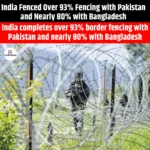Lipulekh Pass Dispute
|
General Studies Paper II: India’s Neighbouring Countries, Bilateral Groupings & Agreements, Effect of Policies & Politics of Countries on India’s Interests |
Why in News?
Recently, India resumed trade activities with China through the Lipulekh Pass route. Nepal raised objections saying the region belongs to it but India dismissed the claims by pointing to historical records and continuous traditional trade through the pass.
Background of the Lipulekh Pass Dispute
- Lipulekh Pass is situated high in the Himalayas at the meeting point of India, Nepal, and China. It sits at about 17,000 feet (around 5,300 m) in Uttarakhand’s Pithoragarh district. It connects India with Tibet (China) and forms part of a tri-junction involving Nepal.
- In 1997, Nepal formally protested the use of Lipulekh for Indian-Chinese travel to Mount Mansarovar. Nepal refers to the 1816 Treaty of Sugauli to justify its territorial claim over the region. That move gave early shape to the longstanding dispute.
- In 2015, India and China decided to open a trade route through Lipulekh, which Nepal strongly opposed. It argued that the agreement disregarded its sovereign claims to the area.
- In November 2019, India released a new map marking Kalapani, Lipulekh, and Limpiyadhura as part of its territory. Nepal objected to this map.
- In April/May 2020, India opened an 80 km road from Dharchula to Lipulekh Pass. The road aimed to shorten the Kailash–Manasarovar yatra significantly. Nepal protested strongly against it.
- In May 2020, Nepal adopted a new political map under its Second Amendment Bill. Nepal’s official map included Limpiyadhura, Lipulekh, and Kalapani within its borders. The amendment passed both houses of Nepal’s Parliament by unanimous vote, and the President signed it in June 2020.
- In August 2025, India and China agreed to resume border trade via Lipulekh, Shipki La, and Nathu La during China’s Foreign Minister visit. Nepal objected again calling the area its own.
|
India–Nepal Border Dispute Areas
|
Nepal’s Stand and India’s Historical Evidence
-
- Nepal: Nepal argues that the Treaty of Sugauli (1816) signed with the British East India Company sets its western boundary along the Kali River. Nepal believes the Kali River originates at Limpiyadhura, west of Lipulekh, supporting its claim. By this interpretation, Kalapani, Lipulekh, and Limpiyadhura fall inside Nepal’s territory. Nepal believes the colonial boundary changes after the treaty reduced its rightful land.
- Nepal consistently asked India to hold foreign secretary-level talks to resolve the boundary issue. In 2020, Nepal formally requested India to start negotiations over the border issue.
- Nepal also raised the issue in international forums. Nepalese leaders mentioned the dispute in their statements at the United Nations General Assembly and during visits to friendly nations.
- In 2021, 2022, and 2023, successive administrations reaffirmed that the Lipulekh region belongs to Nepal.
- Nepal: Nepal argues that the Treaty of Sugauli (1816) signed with the British East India Company sets its western boundary along the Kali River. Nepal believes the Kali River originates at Limpiyadhura, west of Lipulekh, supporting its claim. By this interpretation, Kalapani, Lipulekh, and Limpiyadhura fall inside Nepal’s territory. Nepal believes the colonial boundary changes after the treaty reduced its rightful land.
- India: India asserts that Lipulekh, Kalapani, and Limpiyadhura have historically been part of Indian territory. India refers to colonial-era maps and administrative records from the British period. These maps, including the Survey of India maps from 1827, 1846, and 1920, show the Kali River originating near Lipulekh and Pankhagad stream. India maintains that the region has been administered from Uttarakhand for decades.
-
- India has controlled the area since the mid-20th century, including Kalapani, which has been under Indian security forces since 1962 after the India-China war.
- India refers to the Treaty of Sugauli (1816), which highlights that the treaty set the Kali River as the boundary, but the river’s origin was interpreted differently by British cartographers over time.
- India rejects Nepal’s interpretation of the Kali River origin. India states that the river’s true source is near the Pankhagad stream, east of Limpiyadhura.
- India points out that the 1950 India-Nepal Treaty of Peace and Friendship allows for communication and negotiation, but does not change historical boundaries.
Strategic and Economic Significance of Lipulekh
- Military Importance: Lipulekh Pass lies at the tri-junction of India, China, and Nepal. India has maintained a security presence in the region since the 1962 war with China. The pass allows India to monitor Chinese movements in Tibet and secure northern borders. It is strategically vital for border defense and military logistics in Uttarakhand.
- Trade Route: Lipulekh acts as a traditional trade route connecting India and Tibet. India uses it to facilitate trade with China, especially for local Himalayan communities. In 2015, India and China also planned to upgrade the Lipulekh trade route for smoother movement. The road allows the transport of goods, including essential supplies, improving local economies.
- Religious Tourism: Lipulekh provides access to Mount Kailash and Lake Mansarovar, important for Hindu and Buddhist pilgrims. Every year, thousands of Indian pilgrims use the Lipulekh Pass to travel to Mount Kailash. Pilgrimage traffic boosts tourism revenue, accommodation, and local trade in Pithoragarh district.
- Regional Connectivity: The Pithoragarh-Lipulekh road connects remote Himalayan villages to India’s main road network. This road promotes economic development, health services, and education access for border communities. Maintaining the pass ensures both strategic control and regional growth.
Way Forward
- Bilateral Dialogue: India and Nepal should hold regular high-level talks to address border concerns. Dialogue can reduce misunderstandings and build trust. Open communication can prevent escalation of tensions.
- Joint Survey Mechanism: Both countries can form a joint survey team to verify maps and border markers. Using modern geospatial technology ensures accuracy and transparency. A survey conducted with shared data strengthens confidence in territorial claims and reduces disputes.
- Maintain Security and Sovereignty: India and Nepal should ensure border security without undermining each other’s claims. Military and police presence must balance strategic needs and diplomatic sensitivity. Clear protocols for patrols and checkpoints can prevent incidents and maintain peace.
- Local Economic Cooperation: India and Nepal can encourage cross-border trade and tourism in the Lipulekh region. Pilgrimage and trade routes should benefit border communities. Coordinated development projects since 2020 show that economic cooperation improves relations and mutual trust.










